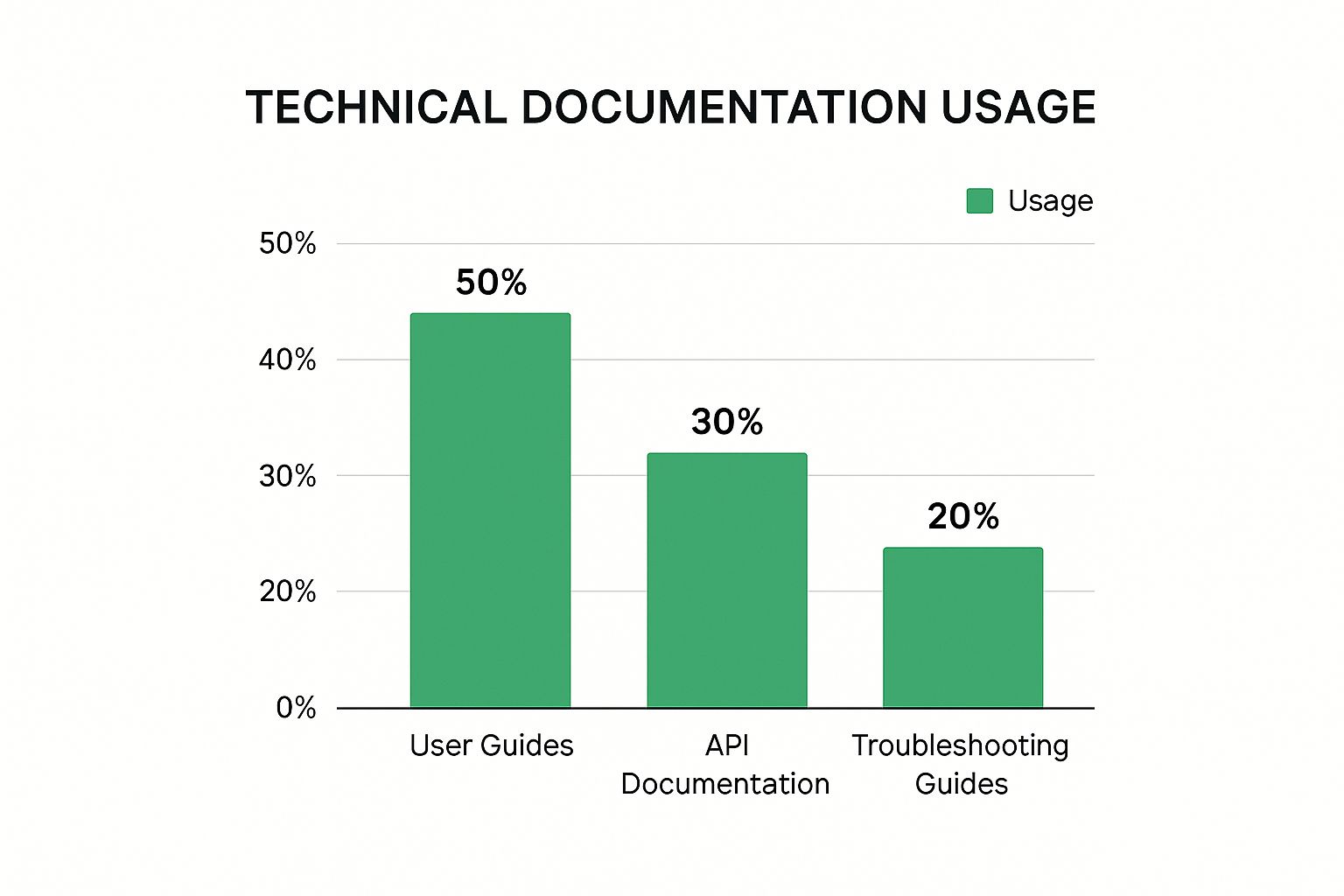Learn what is a technical documentation, why it's important, and how to create effective docs that enhance user understanding. Discover key strategies today!
Technical documentation might bring to mind thick, dusty manuals. But in reality, it’s a vital, dynamic tool. It bridges the gap between complex systems and their users, explaining everything from software to machinery. This makes effective technical documentation a strategic asset, not just an afterthought.
Technical documentation comes in many forms, each with a specific audience and purpose. This ensures information is clear and accessible. Let’s explore some common types:
To illustrate these different types more clearly, let’s examine a comparison table:
A comprehensive overview of the different categories of technical documentation and their specific purposes within organizations:
This table highlights how each documentation type serves a unique purpose. For instance, user manuals focus on practical use, while API documentation dives into technical details. Learn more about mastering technical documentation: How to master technical documentation.
The need for clear, concise technical documentation is increasing. This is fueled by complex products and software, regulatory compliance, and the shift towards digital workflows. The growth of the global business process documentation tools market demonstrates this. The market grew from ****2.16 billion in 2025, an 11.6% CAGR. It’s expected to reach $3.3 billion by 2029 as organizations prioritize digital workflows, remote collaboration, and automation. This aligns with broader IT spending, with the US accounting for 35% of global digital transformation investments, showing the significant investment in improving processes, including documentation. Find out more about business process documentation tools: here.
The following data chart displays the projected growth of the technical documentation software market:

This chart highlights the substantial projected growth from 2024 to 2029. The key insight is the increasing importance of technical documentation as a crucial business function, shifting from a cost center to an investment in user success and business growth. As technology evolves and user expectations rise, the need for robust, accessible documentation will only intensify.
What separates truly effective technical documentation from the kind that sits unused? It’s the thoughtful inclusion of key elements that transform technical details into a practical resource. This means structuring content logically, balancing technical depth with user-friendliness, and incorporating visuals to aid understanding. Let’s explore these elements further.
Effective technical documentation begins with a clear structure. A logical framework is essential, just like building a house requires a solid foundation. This involves organizing information in a coherent flow, using headings, subheadings, and bullet points to break down complex topics. This helps users quickly locate specific information without having to sift through dense paragraphs of text. You might find this helpful: How to master software documentation best practices.
While technical details are important, they must be presented clearly. Avoid using jargon or overly technical language whenever possible. Explain complex concepts using analogies and real-world examples to make the information accessible to a broader audience. For example, using a family tree analogy to explain database relationships can significantly improve understanding. This clarity ensures that even non-technical users can easily understand and use the documentation.
Visuals, such as diagrams, charts, and screenshots, can greatly enhance technical documentation. They can illustrate complex processes, emphasize important information, and break up large text blocks. However, visuals should be used strategically and purposefully, not just for decoration. Each visual element should add value and help users understand the technical information.
Documentation must adapt to different audiences while maintaining consistency. It’s important to understand the needs and technical expertise of your target users. For example, user manuals for consumers will differ greatly from API documentation for developers. However, a consistent style, tone, and terminology should be used across all documentation types to provide a unified user experience.
Achieving a balance between comprehensiveness and usability is essential. Documentation should be thorough but not overwhelming. Prioritize the most important information and avoid unnecessary details. Focus on the user’s core needs, offering concise, actionable information so they can quickly accomplish their goals. Consider also how technology can enhance efficiency. Intelligent Document Processing (IDP) plays an increasingly significant role. The IDP market reached a global size of $2.3 billion in 2024 and is projected to grow at a 24.7% CAGR through 2034. This growth is fueled by the need for automation and increased accuracy in document processing. Learn more: here.

Creating effective technical documentation is more than just writing; it’s about building a structured process. Successful teams use a process that covers everything from initial planning to continuous improvement, ensuring the documentation truly serves its purpose.

The first step is planning. This involves defining the scope of the documentation, identifying the target audience, and setting clear objectives. For instance, is the documentation for end-users, developers, or internal teams?
Gathering technical insights from subject matter experts is also crucial. This ensures the information is both accurate and complete. This initial phase builds the foundation for the entire documentation process.
Next is the actual writing. This stage involves transforming complex technical details into accessible content. This means using clear language, avoiding jargon, and using visuals like diagrams and screenshots.
But writing is only one piece of the puzzle. A robust review process is essential for validating accuracy and ensuring clarity. The review shouldn’t be an endless cycle, but a streamlined system for feedback and improvement. This iterative approach ensures quality and efficiency.
Effective management of documentation projects is key to delivering on time and within budget. This involves establishing clear workflows, assigning responsibilities, and tracking progress. Using project management tools can be very helpful.
This structured approach keeps documentation projects on track and aligned with overall product development goals.
Finally, documentation isn’t a one-time task. It requires continuous improvement and regular updates. This means gathering user feedback, analyzing usage data, and incorporating changes based on evolving product features.
This ongoing maintenance ensures the documentation remains a valuable resource throughout the product lifecycle. Effective technical documentation becomes a living document that grows and evolves alongside the product itself.

Creating clear, concise, and accessible technical documentation is more critical than ever. Thankfully, we’ve moved beyond simple word processors. Today’s tools and platforms offer powerful features that streamline the entire documentation process, from creation and management to delivery.
Modern documentation platforms offer a range of features that simplify the documentation lifecycle. These platforms often include version control, allowing teams to track changes and revert to previous versions if needed. Collaborative editing features enable multiple authors to work on the same document simultaneously, improving efficiency and consistency. And content reuse capabilities minimize redundancy and ensure consistency across all documentation. Built-in search functionality makes it easy for users to quickly locate the information they need.
A Content Management System (CMS) provides a structured approach to organizing and managing large volumes of technical documentation. This is especially valuable when multiple authors contribute to the documentation. A CMS can streamline workflows by integrating with other tools, such as version control systems and translation software. Choosing the right CMS can significantly improve efficiency and maintain consistency across your documentation.
Artificial Intelligence (AI) is transforming the way technical documentation is created. AI-powered tools automate time-consuming tasks like generating code documentation, translating text, and creating initial drafts of user manuals. DocuWriter.ai is one example of a platform offering AI-powered automation for code and API documentation. While AI won’t replace human writers, it can significantly increase efficiency by handling routine tasks, allowing writers to focus on more complex aspects of documentation.
Technological advancements aren’t the only driving force behind the shift to digital documentation. Regulations, such as the European Commission’s 2025 mandates for digitalizing machinery instructions, are accelerating the transition from static print documents to dynamic, interactive technical documentation. This shift not only ensures compliance but also improves accessibility and reduces costs. Companies are increasingly incorporating multimedia elements like interactive schematics and video guides into their documentation. Learn more about these evolving trends: Explore technical documentation trends for 2025.
Selecting the right tools for your documentation needs requires careful consideration. Factors such as team size, product complexity, and budget play a crucial role. Smaller teams with simpler products might find a basic documentation platform sufficient. Larger organizations with complex products may benefit from a robust CMS and the assistance of AI-powered tools. The key is to assess your specific requirements and choose tools that can adapt and scale as your needs evolve. Strategic implementation of the right technologies can transform your technical documentation into a valuable asset for your organization.
How do you prove that technical documentation is a worthwhile investment? This section explores the challenge of measuring its impact and obtaining the necessary resources. Through practical examples and expert advice, we’ll discover how successful documentation leaders move beyond simple metrics to showcase the real return on investment (ROI).
Effective technical documentation directly influences key business outcomes. It’s not just an expense; it’s an investment in user success. This means linking documentation quality to tangible advantages such as lower support costs, better product adoption, and increased customer satisfaction.
This shift in perspective—viewing documentation as a valuable asset rather than a cost—is essential for gaining support from stakeholders.
Modern organizations utilize documentation analytics to demonstrate value. These analytics monitor metrics such as search queries, page views, and user feedback. This data reveals the information users seek, which content is most effective, and where improvements are necessary.
By tracking these metrics, you can pinpoint areas where users struggle, refine the documentation, and monitor the impact of changes.
A clear connection exists between documentation and customer retention. When users easily find the information they need, they are more likely to continue using your product or service. Conversely, subpar documentation can lead to frustration and customer churn. Investing in robust documentation is an investment in long-term customer relationships.
Consider how technical documentation influences user satisfaction, impacting renewal rates and overall revenue.
To secure resources for documentation, you need a convincing business case. This involves:
A strong business case demonstrates the value of technical documentation in concrete terms, justifying the investment.
To understand how to measure the ROI of technical documentation, let’s examine some key metrics. The following table outlines several important performance indicators.
Technical Documentation ROI Metrics: Key performance indicators for measuring the business impact and return on investment of technical documentation
By tracking and analyzing these metrics, you can showcase the direct influence of technical documentation on business goals. This data-driven approach is vital for advocating continued investment in high-quality documentation. Tools like DocuWriter.ai can help simplify the process of creating and maintaining high-quality technical documentation, contributing to a positive ROI. Learn more about how DocuWriter.ai can improve your documentation process: Explore DocuWriter.ai.
The technical documentation landscape is constantly evolving. Staying ahead requires understanding the key trends influencing how we create, use, and interact with technical content. This includes recognizing the impact of technologies like AI and adapting to changing user expectations.
Artificial intelligence (AI) is already transforming technical documentation. Tools powered by AI are automating tasks such as generating code documentation, translating text, and even drafting user manuals. This automation allows technical writers to focus on more strategic work, like ensuring accuracy, crafting compelling narratives, and tailoring content to specific audiences. This shift emphasizes strategy over rote production, resulting in higher-quality documentation.
Users now expect information in an interactive, conversational format. This means moving beyond static documents and embracing conversational documentation. Think chatbots integrated into help systems, personalized documentation portals, and interactive tutorials. These tools can anticipate user questions, providing proactive guidance and a more dynamic learning experience. For example, a chatbot might guide a user through troubleshooting, offering personalized advice based on their situation.
User behavior is evolving. People consume information in shorter bursts, across various devices, and in diverse formats. Technical documentation must adapt. This might involve creating bite-sized content, optimizing for mobile access, and using multimedia like video and interactive diagrams. Focusing on user experience is critical for engagement and effective information consumption.
The open-source model is impacting documentation. Community-sourced documentation allows users to contribute, share knowledge, and improve documentation collaboratively. This builds a sense of ownership and can result in more comprehensive, up-to-date information. However, it requires careful moderation for accuracy and consistency.
Regulations, like the European Commission’s mandates for digital documentation, are changing documentation practices. These regulations are accelerating the move to digital formats and often emphasize accessibility. Organizations must adopt modern documentation tools and platforms that support compliance, accessibility, and dynamic content delivery.
Staying current requires a proactive strategy. Technical writers and documentation teams should embrace continuous learning, experiment with new tools and technologies, and remain adaptable. This involves focusing on core user needs, prioritizing usability, and fostering continuous improvement.
By understanding these trends, you can create a documentation strategy that’s effective today and adaptable for the future. This means using technology effectively, understanding your users, and prioritizing clear, concise, and accessible technical information.